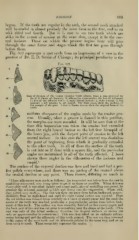Page 989 - My FlipBook
P. 989
EROSION. 999
begun. If the teeth are regular in the arch, the second tooth attacked
Avill be eroded in ahnost precisely the same form as the first, and so on
with third and fourth. But it is rare to see two teeth which are
alike in the extent of erosion at the same date, except it be the cen-
tral incisors. Those on which the process begins later will pass
through the same forms and stages which the first has gone through
before them.
Fig. 582 represents a cast made from an impression of a case in the
practice of Dr. E. D. Swain of Chicago ; its principal peculiarity is the
Fig. 532.
Case of Erosion of the Lower Anterior Teeth (drawn from a cast prepared by
Dr. E. D. Swain of Chicago) : B, silhouettes representing the loss of substance
ill five of the atTected teeth: 1, right liitcral incisor; J, right cmitral ; 3, left
central; 4, left lateral; 5, left cuspid. The lines aaaaii show the position of
the margin of the gum. A line is drawn also to show the original form of the
tooth.
uniform sharpness of the angles made by the erosive pro-
cess. Usually, when a groove is formed in this position,
the margins are more rounded. It will be seen that at the
time this impression was taken the erosion had extended
from the right lateral incisor to the left first bicuspid of
the lower jaw, with the deepest point of erosion in the left
central incisor. In this case the left central was doubtless
the point of beginning, from which it gradually extended
to the other teeth. In all of these the surface of the teeth
is cut into as if done with a square file, and the particular
angles are maintained in all of the teeth affected. I have
shown these angles in the silhouettes of the incisors and
cuspid.^
The surface of the exposed dentine was firm and hard and had a per-
fect polish everywhere, and there was no jutting of the enamel above
the eroded dentine at any point. These tissues, differing so much in
1 Tliese silhouettes were made as follows An impression Mas taken from the cast in
:
modelling!; compound, care being taken to get it as sharp as possible. When this was
thoroughly cold, ii was oiled lightly and a cast made, also of modelling compound, by
]>ressing the softened material quickly and firmly into the- impression. When cold,
they parted very readily. The cast was then cut away from before backward, perpen-
dicularly, from its right-hand end until tlie right lateral incisor was reached. Then
the cut surface was dressed down carefully on a piece of emery-paper laid flat until the
centre of the tooth was' reached, ju-oducing a perpendicular section from before back-
ward of this tooth. The surface was then smoothly finished on fine emery-paper, and
the back part of the cast was cut away to something near the shape of the tooth. (This
cast was only of the labial surfaces; therefore the lingual surfaces as shown are
only an approximation to correctness.) This was then inked on an ordinary rubber-
stamp inking-pad and the silhouette of this tooth jirinted. The cast was then trimmed
to the centre of the next tooth and its siliiouette printed in the same way, and so on
from tooth to tooth. The.se accurately represent the angles.


